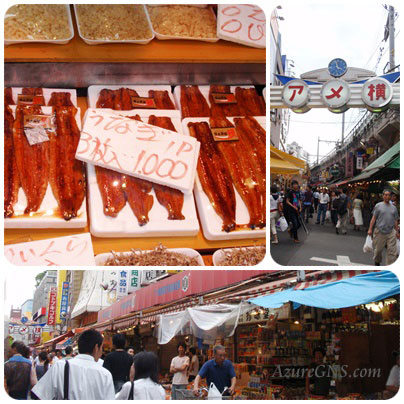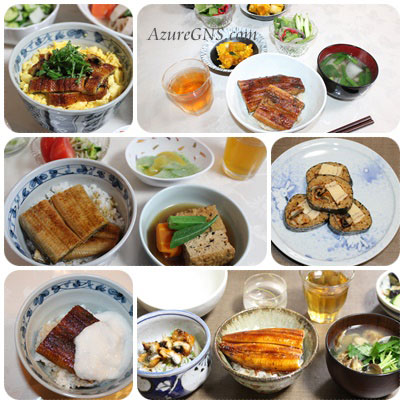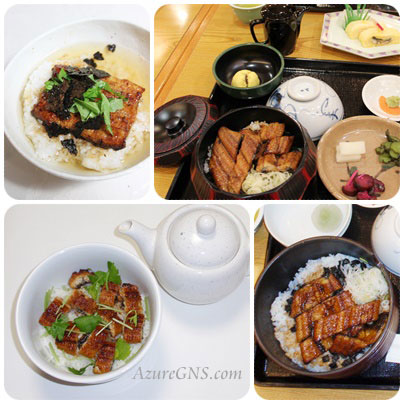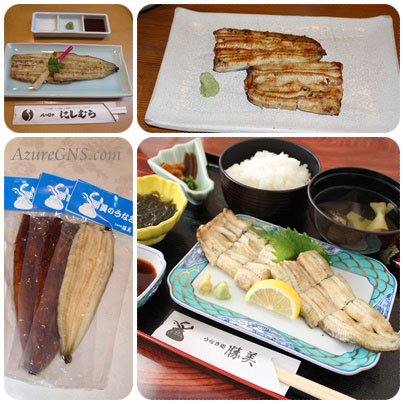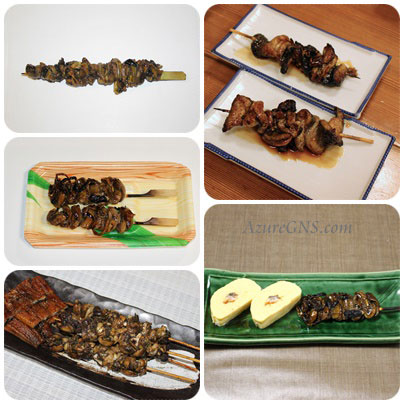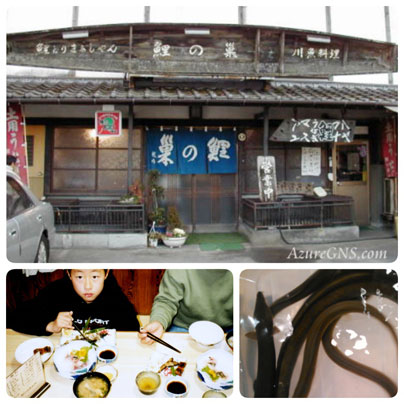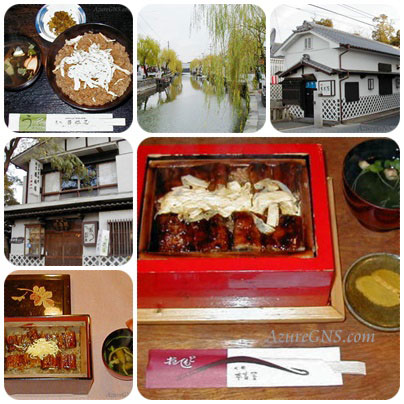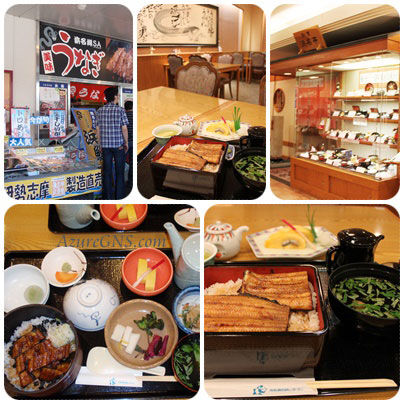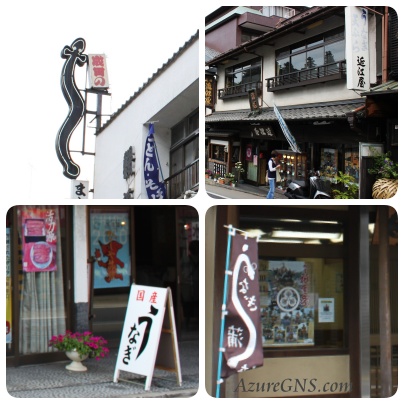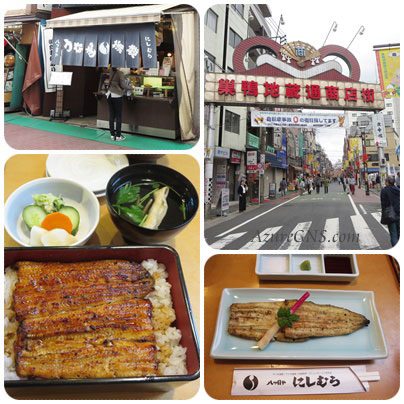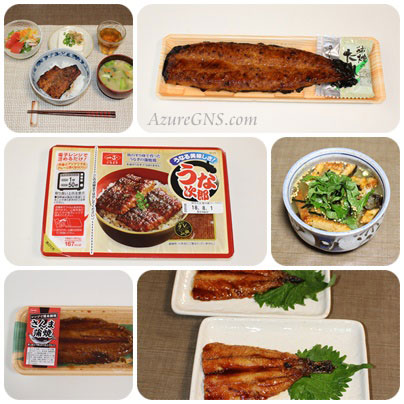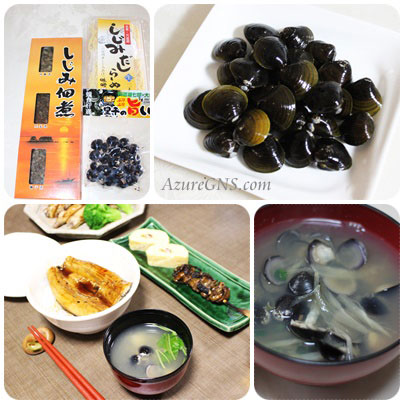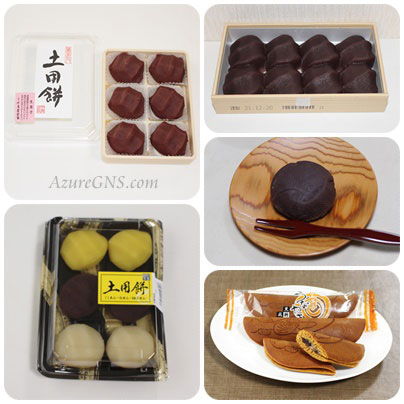Wagaya no Doyo-no-ushi-no-hi;
Our Dog Day of Summer Experience
毎年土用の丑の日には、鰻屋はお客さんで混雑します。テイクアウトも用意されています。国産鰻は年々高価になっているため庶民の口にはなかなか入りませんが、土用の丑の日には多くの人がささやかな贅沢を楽しみます。開いた鰻を、醤油、砂糖、味醂、酒などで作った鰻のタレをつけながら焼くと鰻の蒲焼きになります。鰻を焼く香ばしくて甘辛い匂いが通りいっぱいに広がり、食欲をそそります。
Eel restaurants are crowded with customers eating eel on Doyo-no-ushi-no-hi every year. Eel for takeout is also available. The price of Japanese eel has been rising so high that ordinary people do not eat it very often. However, we enjoy a small luxury on a special eel day, Doyo-no-ushi-no-hi. Unagi-no-kabayaki is an eel split and grilled with rich teriyaki sauce (mixture of soy sauce, sugar, sweet sake and sake). Nice smell of sweet and salty grilled eel spreads around the streets and it stimulates our appetite.
通常、家庭で鰻を食べる時は調理された鰻を魚屋や食料品店で買ってきます。土用の丑の日にスーパーの前を通ると鰻の蒲焼の特別屋台が出ています。スーパーのチラシでも土用の丑の日の鰻の蒲焼を毎年盛んに宣伝しています。土用の丑の日が近付くと、店内は鰻の装飾品、提灯、張り紙で飾られ、お客さんの購買意欲をかき立てます。
When we eat eel at home, we usually buy prepared eel at fish shops or grocery stores. There are special stalls of unagi-no-kabayaki at the supermarket on Doyo-no-ushi-no-hi. Unagi-no-kabayaki for Doyo-no-ushi-no-hi is enthusiastically advertised in the fliers of supermarkets every year. When Doyo-no-ushi-no-hi is drawing near, the insides of the stores are decorated with eel-shaped ornaments, paper lanterns and posters to increase customers’ eagerness to buy.
東京都台東区上野のアメ横は賑やかな商店街で、多くの食料品店や衣料品店がひしめき合っています。いつも地元の人や国内外からの観光客でごった返しています。その活気ある雰囲気が面白くて、年に数回足を運びます。土用の丑の日の数日前に行くと、ずいぶん安価で鰻の蒲焼きが売られていました。値段から判断して輸入ものだと思います。アメ横の起源は、空襲によって焼け野原になった土地に第二次世界大戦直後できた闇市です。当時、アメリカ製品が売られていました。また飴屋もたくさんありました。アメ横の正式名はアメヤ横丁で、「アメ」の語源は2つの説があります。アメリカという説と飴という説です。
Ameyoko in Ueno, Taito Ward of Tokyo is a busy shopping street with a lot of grocery stores and clothing stores. Ameyoko is always crowded with both local people and tourists from domestic and overseas areas. We enjoy walking along Ameyoko full of vigor several times a year. When I went to Ameyoko a few days before Doyo-no-ushi-no-hi, many unagi-no-kabayaki were sold at low prices. Judging from the price, these eels were imported ones. The origin of Ameyoko is a black market opened on a field, which was burned by air raids, soon after World War ll. In those days, American products were sold, and there were also a lot of candy stores. Ameyoko represents Ameya Yokocho (an Ame store alley). There are two theories for the origin of the name “Ame”. Some say “Ame” is from “America”, others think it comes from the Japanese word for candy, “ame”.
関東では、まず硬い頭を切り落として、背開きにします。関西と違って、焼く前に蒸します。関西の鰻の蒲焼は腹開きで、頭がついたまま焼きます。うなぎはしばしば串を刺して焼くこともあります。国産の鰻の蒲焼は1尾およそ3000円前後です。輸入ものはもう少し安価です。蒲焼には小さな容器に入ったタレが付いているので、タレをかけて電子レンジで温めます。
In the Kanto district, the hard heads of eels are cut off first, and bodies are split on the back sides. Different from in the Kansai district, eels are steamed before they are grilled. In the Kansai district, eels are split on the stomach sides, and they are grilled with the head attached.Eels are often grilled on a skewer. One unagi-no-kabayaki of a Japanese eel costs around 3000 yen. Imported eels are less expensive. Grilled eel is usually sold with a small pack of special teriyaki sauce. People put special teriyaki sauce on unagi-no-kabayaki and microwave it.
御飯の上に蒲焼をのせ、タレをかけると鰻丼になります。うな茶漬けは鰻丼よりあっさりとしています。ご飯に鰻の蒲焼を細く切ったものに三つ葉、葱、大葉、海苔、山葵などの薬味をのせてお茶か出汁をかけて食べる料理です。錦糸玉子をそえることがあります。鰻と卵を芯にして、鰻のタレで味付けしたごはんを海苔で巻いた鰻巻き寿司もあります。
Unagi-no-kabayaki and special teriyaki sauce for unagi on rice in a bowl is called unagi-domburi. Una-chazuke is lighter than unagi-domburi. Una-chazuke is a rice bowl dish of unagi-no-kabayaki with toppings like mitsuba (Japanese honewort), negi (Japanese leek), oba (green perilla), nori (dried laver or seaweed) or wasabi (Japanese horseradish) in tea or stock. Kinshi-tamago (egg fried and cut thin like golden thread) is also sometimes added. Unagi-makizushi is a kind of sushi containing strips of unagi-no-kabayaki and fried beaten egg in the center, rice seasoned with special teriyaki sauce for unagi and rolled with a sheet of nori.
私の最も好きな鰻の食べ方はひつまぶしです。愛知県名古屋市が発祥の鰻料理です。細く切った鰻の蒲焼がひつに入ったご飯にのせて出されます。ひつまぶしは一般的に3種類の食べ方を楽しみます。お茶碗に入れて、まずそのまま食べます。次は海苔、葱、三つ葉、山葵などの薬味をのせて食べます。そして最後にお茶、またはお出汁をかけます。
My favorite way to eat eel is hitsu-mabushi, eel dishes whose birthplace is Nagoya City, Aichi Prefecture. The rice, with thin-cuts of unagi-no-kabayaki on it, is served in hitsu (a rice tub). We usually enjoy hitsu-mabushi in three ways. At first, we put it in a rice bowl and eat it without adding anything. Next, we eat it with toppings like nori, negi, mitsuba or wasabi. At last we pour some tea or stock into the rice bowl of hitsu-mabushi.
何も付けずに直火で焼いた鰻は白焼きと呼ばれます。塩、醤油、ポン酢などで食べるのが一般的です。摺り下ろした少量のわさびや生姜を添えて食べると、鰻本来の旨味が一層引き出されます。白焼きはシンプルな調理法なので、鰻本来の旨味と鮮度が勝負になります。最近の低炭水化物ダイエットの流行で、砂糖がたくさん入っているタレ焼の鰻より、白焼きを好む人も増えています。私は白焼きが大好きで、いろいろな鰻の名店へ足を運んで食べ比べています。
Eel grilled without any sauce on an open fire is called unagi-no-shirayaki. Salt, soy sauce or pon-zu (soy sauce with citrus juice) goes well with shirayaki. A small amount of grated wasabi or ginger brings out more original flavor of eel. The cooking method of shirayaki is very simple, therefore the quality and freshness of eel are very important to make delicious shirayaki. As a low-carbohydrate diet is popular nowadays, shirayaki is eaten more than unagi-no-kabayaki grilled with special sauce containing a lot of sugar. I like shirayaki very much and eat it at various famous eel restaurants.
う巻きと呼ばれる蒲焼を芯にして焼いた玉子焼きもよく食べられます。レストランでは大根おろしやハジカミがあしらいとして添えられます。店によってう巻きの味や焼具合はさまざまです。鰻も卵も大好きな私にとって、う巻きは最高の一品です。
“Umaki”, a rolled omelet with unagi-no-kabayaki in the center, is also popular. Umaki often served with daikon-oroshi (grated daikon radish) and haji-kami (pickled ginger root). Methods of seasoning and baking vary from restaurant to restaurant. Umaki is a perfect dish for me because I love both eel and eggs.
鰻の肝も栄養価が高く、スタミナ食として人気があります。ビタミンAやEが豊富で目や美肌に良いと言われています。串に刺し、鰻の蒲焼と同じようにタレをつけて焼かれます。新鮮で上質の肝でないと、苦みや臭みが出てしまいます。また見た目も独特なので、好き嫌いの好みが分かれます。私が幼かった頃、よく母が姉や私に買ってきて、目に良いからと食べさせられました。その頃はまだ多くの天然鰻を釣り竿で釣っていたため、時々肝の中に釣り針が残っていたので、気をつけて食べなければいけませんでした。
Eel liver is also very popular as a health food. It is rich in vitamin A and E; therefore it is good for the eyes and keeps the skin beautiful. Kimo-yaki is the eel liver skewered and grilled with the special teriyaki sauce like unagi-no-kabayaki. If fresh and high-quality liver is not used, it can be bitter and smells peculiarly. Moreover, it does not look delicious, therefore, some favor it and others not. When I was a small child, my mother often bought kimo-yaki for my sister and me for our eyes. Those days, many natural eels were caught with a fishing rod, and the fishhook was sometimes left in the eel liver, therefore we had to be careful when we ate kimo-yaki.
飲食店で鰻を食べる時、しばしば肝吸いも添えられます。脂の載った鰻に、あっさりとした肝吸いはよく合います。「肝」という名前ですが、実際は鰻の肝臓ではなく、胃、腎臓、腸などの湯通しした内臓が入ったすまし汁です。仕上げに三つ葉を盛ります。家庭用にインスタントの肝すいも売られています。これは茹でた鰻の内臓、粉末調味料、乾燥三つ葉と麩(小麦のグルテンが原料の日本の伝統的な食材)がセットになっていました。
People often eat kimo-sui (clear eel organ soup) with unagi-domburi. Kimo-sui goes well with fatty eel. “Kimo” literally means liver but actually liver is not included. Kimo-sui is clear soup containing boiled organs of eels such as stomach, kidney and bowel with mitsuba on top. Instant kimo-sui is sold for family use. This consists of boiled eel organ, powdery seasoning, and dried mitsuba and fu (traditional Japanese food made from wheat gluten).
骨煎餅は鰻の骨を低温の油でじっくり素揚げして、塩で味付けしたスナックです。見た目は少しインパクトがありますが、ポリポリした食感のビールに合う美味しいおつまみです。カルシウムやビタミンが豊富なので子供のおやつとしても最適です。ほとんど廃棄されていた大量の鰻の骨を活用するために開発され、今では静岡県の名産品のひとつです。鰻料理店で料理ができるまでのつなぎとして出されることもよくあります。
Hone-sembei is a type of snack which is eel bone fried in deep oil at a low temperature for a long time and seasoned with some salt. It looks a little strange, but it is actually a crispy delicious snack going well with beer. It is also good for children because of a lot of calcium and vitamins. The product of fried eel bones was produced to utilize a huge amount of eel bones most of which used to be disposed and now this is one of the specialties in Shizuoka Prefecture. Some eel restaurants serve fried eel bone to customers to eat while they are waiting for what they ordered.
1999年(平成11年)福岡県久留米市の和食店の鯉の巣へ家族で行きました。鯉料理が有名なお店ですが、鮎、鮠(はや)、田螺(たにし)、川海老の料理もあります。珍しい天然鰻もその日は食べることができました。養殖の鰻に比べて身が締まり、脂が少なかったです。
In 1999 (Heisei 11th yr), my family and I went to Koi-no-su, a Japanese restaurant, in Kurume City, Fukuoka Prefecture. This restaurant is famous for carp dishes. They also serve dishes of a sweet fish, a dace, a pond snail, and a river shrimp. On that day, we could have rare natural eel. It was firmer and lighter than cultivated eel.
福岡県柳川市には美味しい鰻料理を出す店が多くあります。本吉屋は1615年(元和元年)創立、鰻のせいろ蒸し元祖の店だそうです。タレをまぶしたご飯の上に鰻の蒲焼と金糸玉子を載せ、セイロで2度蒸します。若松屋は柳川市でもっとも有名な鰻料理店のひとつで、安政年間(1854-1860)の創業です。こちらも錦糸玉子が載った鰻のセイロ蒸しが有名なお店です。長年継ぎ足して作った秘伝のタレで焼いた香ばしい鰻は絶品でした。
There are many restaurants which serve good eel dishes in Yanagawa City of Fukuoka Prefecture.
Motoyoshi-ya was established in 1615 (Genna 1st yr), and it was the first restaurant which served seiro-mushi. They put unagi-no-kabayaki and kinshi-tamago on rice seasoned with special sauce in seiro (a bamboo woven basket for steaming food) and steam it twice. Wakamatsu-ya, established in the era of Ansei (1854-1860), is one of the most famous eel restaurants in Yanagawa City. This restaurant is also famous for unagi-no-seiro-mushi with kinshi-tamago on top. The fragrant eel grilled with a long-kept secret sauce was superb.
東京と関西を行き来する生活を続けています。仕事の資料やコンピューターなど荷物が多かったり、犬が一緒だったりするので、公共交通機関を使わず、ほとんどの場合自分達で車を運転して移動します。よく立ち寄る高速道路のサービスエリアやパーキングエリアの1つが、浜名湖サービスエリアです。そこから鰻の養殖で有名な浜名湖を一望できます。この湖は豊富な地下水があり、かつては浜名湖に鰻の稚魚が遡上していました。周辺で餌になる蚕のサナギが十分に手に入ったり、気候が一年中穏やかだったり、物流にとって好立地でした。このような理由から、1900年(明治33年)に始まった鰻の養殖は発展し続け、全国的に有名になりました。
We go back and forth between Tokyo and the Kansai area in our daily life. We need to bring a lot of belongings especially materials for work and our computers, and our dogs usually come with us; therefore, we hardly travel by public transportation but drive our car by ourselves. Hamanako (Lake Hamana) Service Area is one of the service areas and parking areas on the expressway where we sometimes take a rest during our driving. It commands a panoramic view of Lake Hamana which is famous for eel farming. The lake is rich in groundwater, and juvenile eels once swam upstream into the lake. Moreover, silkworm chrysalises were easy to get for feeding eels around the lake, the climate was mild all the year round and it was a good location to transport. For these reasons, Lake Hamana had developed since 1900 (Meiji 33rd yr) and became one of the most famous eel farming lakes in Japan.
長時間ドライブの何よりの楽しみは高速道路のサービスエリアやパーキングエリアに立ち寄ることです。浜名湖サービスエリアで食事をする時は、鰻を食べることが多いです。他よりお手頃価格で美味しい鰻を食べることができましたが、最近は鰻が高騰して鰻料理も値上がりしています。お気に入りのレストランは鰻料理専門店でしたが、鰻以外のメニューも増えています。サービスエリア内では手軽に食べられるテイクアウト用の鰻丼や、真空パック入りの鰻の蒲焼きや白焼きも販売されています。
Stopping by a service area or a parking area is above all a delight for us during a long drive. We often eat eel at Hamanako Service Area. They served us good eel cuisine at more affordable prices than other eel restaurants, but recently the prices have increased because eels themselves are very expensive. Our favorite restaurant which was used to be specialize in eel now has various menus besides them. Reasonable unagi-donburi for take-out and vacuum-packed unagi-no-kabayaki and unagi-no-shirayaki are also sold in the service area.
成田山新勝寺参拝での楽しみは周辺に60軒ほどひしめく鰻屋での食事です。店頭では見事な技で鰻をさばく姿を見ることもできます。2010年(平成22年)にお寺の総門脇にある駿河屋で美味しい鰻を頂きました。駿河屋は元は江戸時代創業の旅館で、数ある鰻屋の中でも3本の指に入ると言われる人気店です。長州備長炭で焼いた鰻は外はカラッと、中はジューシーでした。女将さんとお話をすると、抱っこしているお孫さんは大事な跡継ぎだと嬉しそうにおっしゃっていました。
A meal at one of as many as 60 eel restaurants is pleasure when we visit Naritasan Sinshoji Temple. We also can enjoy seeing a wonderful technique of a professional eel grader. In 2010 (Heisei 22nd yr), I had a delicious eel at Suruga-ya next to the grand gate of the temple. Suruga-ya was originally an inn in the Edo period (1603-1868) and is said to be one of the best three among many inn restaurants. Fire of Choshu binchotan (a high-grade charcoal) makes the outside of eel crispy and the inside juicy. The owner happily told me that her grandson, a young boy in her arms was a cherished successor of the restaurant.
2015年(平成27年)の土用の丑の日の鰻は、東京都千代田区神田末広町にある久保田でいただきました。1897年(明治30年)創業の鰻の名店です。川魚の卸問屋でもあるため、比較的お手頃価格で、絶品の鰻を出してくれます。肝焼には、1串に2,3匹分の新鮮な肝が使われていて、今まで食べた肝焼の中で最高でした。鰻以外に、どじょうの柳川鍋や鯉のあらいも注文しました。私は川魚は苦手ですが、夫も息子も好きなので喜んで食べていました。
In 2015 (Heisei 27th), we enjoyed eel of Doyo-no-ushi-no-hi at Kubota in Kanda-suehiro-cho Chiyoda of Tokyo. Kubota is a highly reputed eel restaurant that has been loved since 1897 (Meiji 30th yr). It is also a wholesaler of freshwater fish; therefore, they offer superb eel dishes at rather lower prices. Kimo-yaki containing fresh liver of 2 or 3 eels was the best I have ever had. Besides eel dishes, we ordered dojo-no-yanagawanabe (loaches cooked with beaten egg) and koi-no-arai (slices of half boiled carp rinsed in cold water). I was not a big fan of freshwater fish, but my husband and son delightfully ate their favorite dishes.
とげぬき地蔵尊の参道で、中山道(江戸時代の主要な五街道の1つ)の一部だった巣鴨地蔵通り商店街に食堂を併設した有名な鰻店のにしむらがあります。この商店街は年配の人に人気があり、にしむらの店内も私と同年代のお客様が多かったです。こちらのお店の名物の一つは八目鰻のお料理ですが、味に少しクセがあるので、夫と私は普通の鰻料理にしました。とても美味しい鰻重、白焼き、肝吸いを頂きました。
There is a famous eel store and restaurant, Nishimura, along Sugamo Jizo-dori Shopping Street, which is the approach of Togenuki-Jizo-son: a part of the Nakasendo (one of the five major highways in the Edo period). This shopping street is popular among elderly people and many of the customers in Nishimura were in the same generation as mine. Yatsume-unagi (lamprey eel) dishes are among this restaurant’s specialties, but it has a bit of a strong taste, therefore my husband and I chose ordinary eel dishes. We had great Una-ju (Unagi-no-kabayaki on rice in a square box), shirayaki and kimo-sui.
東海道旧道の逢坂関所跡からすぐのところに逢坂山かねよがあります。1872年(明治5年)創業の鰻の名店で、800坪の歴史を感じさせる庭園を臨むお座敷で、絶品の国産鰻を頂くことができます。私は2019年の秋に滋賀県でお仕事の際に、本店のお向えにある支店のレストランで、このお店の名物のきんし丼を頂きました。鰻丼の上に卵を3個使ったフワフワのだし巻き玉子が、もの凄い存在感を放っていました。だし巻き玉子も鰻も大好物の私には最強の組み合わせでした。かねよでの昼食後にして車で約30分の比叡山延暦寺に向いました。
There is Osaka Kaneyo located right near the site where Osaka-no-seki (the check point of Osaka) once stood along the ancient Tokaido Road (the ancient Eastern Road). It is a famous eel restaurant established in 1872 (Meiji 5th yr), where exquisite natural eel dishes are served in zashiki (a Japanese-style sitting room) facing an 800-tsubo (about 2,645 square meters) traditional Japanese garden. In autumn of 2019 (Reiwa 1st yr), I went to Shiga Prefecture for business and dropped in the branch restaurant across the street from Kaneyo. I had Kaneyo’s specialty, kinshi-don: a quite surprising unagi-donburi with dashi-maki (a Japanese style fluffy omelet) made from 3 eggs on top. Both dashi-maki and grilled eel are my favorite; therefore this was the perfect combination for me. After lunch in Kaneyo, I visited Hiei-zan Temple which was 30 minutes away by car.
鰻、穴子、鱧など細長い魚が苦手な人がいます。最近は、そんな人のための「鰻もどき」または「なんちゃって鰻」の蒲焼きを食料品店やスーパーマーケットで見かけるようになりました。上記の写真の全ての食材は鰻ではありません。精進料理の場合、豆腐のすり身を海苔に載せて、鰻の形にしてタレを付けて焼きます。魚のすり身を使ったものや、秋刀魚や鰯も鰻の蒲焼きの代用品になります。
Some don’t like a long fish such as a eel, a conger and a pike conger. Recently, “Unagi-modoki” or “Nanchatte-unagi” (fake unagi-no-kabayaki) are sold in groceries and supermarkets for such people. The food in the photos above are not made from eels. In case of Shojin-ryori (Buddhist-style vegetarian meal), the fake unagi-no-kabayaki is made from mashed tofu on a nori sheet in the shape of unagi-no-kayabaki and grilled with the special teriyaki sauce. Finely ground fish is also used for the fake unagi-no-kabayaki and sanma (a saurie) and iwashi (a sardine) can also be substitutes for eels.
土用の時期の蜆は土用蜆と呼ばれます。土用の丑の日に、鰻と共にお味噌汁に入れて食べられます。江戸時代(1603-1868)からしじみは貴重な栄養源として庶民に親しまれています。蜆の旬は盛夏で、特にこの時期の蜆は栄養価が高まり、夏バテや二日酔い解消に効果があり、「土用蜆は腹薬」と言われるほどです。土用蜆は土用鰻や土用餅と共に、俳句の夏の季語になっています。
Shijimi clams in the Doyo season are called Doyo-shijimi. Miso-shiru (miso soup) of these clams is often served with eel on Doyo-no-ushi-no-hi. Shijimi clams have been popular among ordinary people as a valuable source of nutrients since the Edo period (1603-1868). Shijimis in season, midsummer have a high nutritional value and an effect on summer heat fatigue and a hangover, therefore, people describe “Doyo-shijimi as “stomach medicine”. Doyo-shijimi along with Doyo-unagi and Doyo-mochi is a summer season word for haiku (a very short form of Japanese poetry in 3 lines of 5-7-5, only 17 syllables).
土用の丑の日には鰻だけでなく土用餅と呼ばれる和菓子を食べます。その歴史は古く、江戸時代以前より食べられていたようです。土用餅は地方によりさまざまな種類があります。お餅を餡で包んだ「あんころもち」が多いようです。伊勢の赤福が最も有名なあんころ餅のひとつです。「おはぎ」を土用餅として食べる地方もあり、こし餡とつぶ餡があります。
We eat Doyo-mochi (Japanese rice cake for Doyo-no-ushi-no-hi) as well as eel on Doyo-no-ushi-no-hi. It has a long history: people started to eat Doyo-mochi before the Edo era. Doyo-mochi varies from region to region. One of the most popular Doyo-mochi is mochi (a rice cake) covered with anko (or an) (sweetened bean-paste). There are mainly two types anko, koshi-an (strained sweetened bean-paste) and tsubu-an (roughly mashed sweetened bean-paste).
(「土用の丑の日」に戻ります。)
(Back to “The Dog Days of Summer”.)
Copyright (C) Azure Global Network Services. All Rights Reserved.


